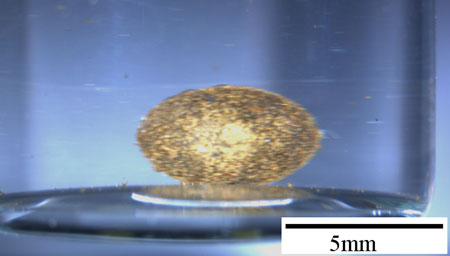| Posted: June 18, 2008 |
Building giant 'nanoassemblies' that sense their environment |
|
(Nanowerk News) Researchers in Texas are reporting the design, construction, and assembly of nano-size building blocks into the first giant structures that can sense and respond to changes in environmental conditions. The study, scheduled for the July 9 issue of ACS's Nano Letters ("Controlled Manipulation of Giant Hybrid Inorganic Nanowire Assemblies") terms those structures "giant" because they are about the size of a grain of rice — millions of times larger than anything in the submicroscopic realm of the nanoworld.
|
 |
| An optical photograph reveals self-assembly of hybrid nanowires resulting in this golden droplet. Such structures could help develop nanomachines for the medical community. (Image: Pulickel M. Ajayan)
|
|
In the new study, Pulickel M. Ajayan and colleagues point out that such structures are a step toward the development of futuristic nanomachines with practical applications in delivering medicines to patients, labs-on-a-chip, and other products. Until now, scientists have had difficulty in using nanomaterials to build more complex, multifunctional objects needed for those applications.
|
|
The researchers describe development of a hybrid nanowire consisting of segments with water-repelling carbon nanotubes on one end and water-attracting metal nanowires on the other end. In laboratory tests, they showed that the nanowires could assemble themselves into larger, more complex structures when placed in water. The structures also sensed and responded to their environment by making movements when exposed to chemicals, magnets, and light. The findings "could lead to the creation of smart materials that are a cornerstone for the development of nanotechnology-based applications," the study notes.
|

